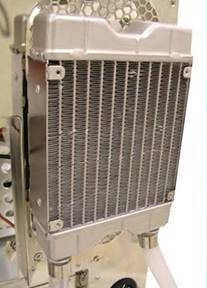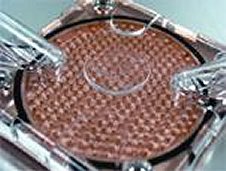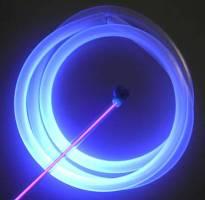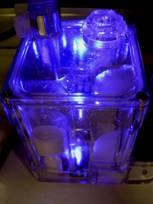| 3D Galaxy LCS Cooler |

|
|
Gigabyte chose to mount the radiator just beneath the power supply using a bracket specially designed for this purpose. The bracket provides a very sturdy mounting and allows for room between the back of the case and the radiator so adequate air flow is achieved.


The radiator uses an adjustable rate 120mm blue LED illuminated fan which as an enthusiast I can honestly say looks really cool and does accent your system well. The fan additionally moves quite a bit of air in both its low and high speeds. In terms of radiator placement and mounting the Gigabyte has really gotten this right. Nice job Gigabyte.
The CPU cooler is a copper based waterblock with a clear plexi-glass top with integrated tube adapters. This is a smart choice as I have personally seen too many waterblocks with excellent construction and a poor implementation of the tube feeds that led to leaks. It should be noted here that through the entire testing of the Galaxy 3D Cooler kit we did not experience a single drop of leakage anywhere in the system. This includes filling and testing the system. The water block has a polished raised rounded CPU mating surface on the bottom which is its single flawed point. The surface itself is polished and very flat, but its area was too small to cover the entire surface of our CPU. This left small areas in each of the four corners uncovered. While we did not experience any temperature issues we cannot help but wonder how much better our temperatures would have been if the entire CPU surface had been covered. The CPU cooler did cover the very center of the CPU heat spreader which is the source of heat on the CPU. Another highpoint of the CPU waterblock is the mounting mechanism. Gigabyte includes a mounting cover meant for socket 939 CPU’s that allows this cooler to sit directly centered over the CPU without room for it to moved out of place. The retention mechanism is reminiscent of old Athlon heatsinks and uses a 3 clip design holder with a simple twist lock that makes installation and removal as easy as the stock heatsink.

Installation of the pump is simple; find any flat surface on which to mount it where it will remain upright. The pump and reservoir are in a mated design with the reservoir integrating a Blue LED for illumination as well as a low fluid sensor. The sensor will sound an alarm if the fluid is low and will shut the system down if it remains low for more than a few seconds.


As you can see the input and output are both at the top of the unit, which is the cause of some trouble in placement. Some users may find that the tubing height and lack of flexibility without kinking will limit placement options. We used an Antec P180 case in testing and our options were still limited. Those with PCI cards in their motherboards, or low PCI-E, or AGP card slots may find that they cannot place the pump in the center bottom of the case and may have to place it beneath the hard drives. The reservoir was simple to fill and provided an easy means to check the fluid level and bleed the system of air.
Tubing was more than adequate at ½ inch, however, ducting
the tubing from inside the case to outside leaves the tubes slightly pinched.
Gigabyte uses a slot cover with two oblong holes meant to pass the tubing
through to the radiator. The slot cover is not wide enough to allow for an
undistorted pass through of the tubing so the tube must be pinched slightly
to allow it through. While this does the job we have seen better implementations
from inside to outside tubing. As with any kits where the radiator is situated
outside the case, the system must be fully assembled before it can be filled
and tested. Gigabyte includes several feet of UV reactive tubing in this kit
which adds to the overall appeal and display of the kit inside your case.
The Galaxy kit is perfectly at home situated inside a case that includes a
window.




In addition to the tubing, Gigabyte provides a specialized blue fluid for users to fill the system with. The fluid comes in a large bottle with a dispenser cap which makes filling the system a breeze. The fluid acts as more than just a heat transfer agent, it also functions to inhibit biological growth in the tubes similar to antifreeze. We are happy to report that in our testing the fluid does not stain the tubing and remained completely clear and free of contaminants, particles, or bubbles even after several weeks. Particulate contamination is second only to bubbles as factors that decrease cooling performance.
| « System Overview | Performance » |



